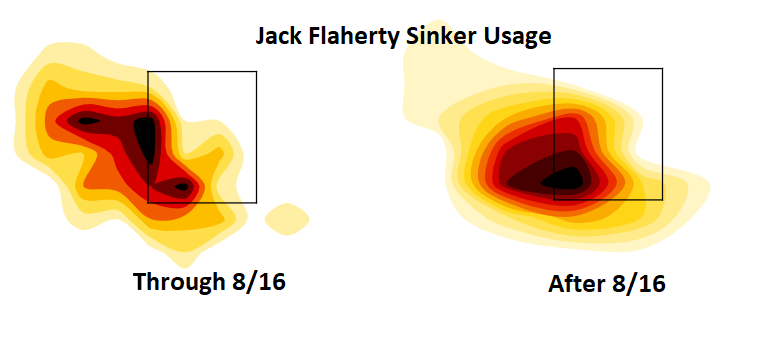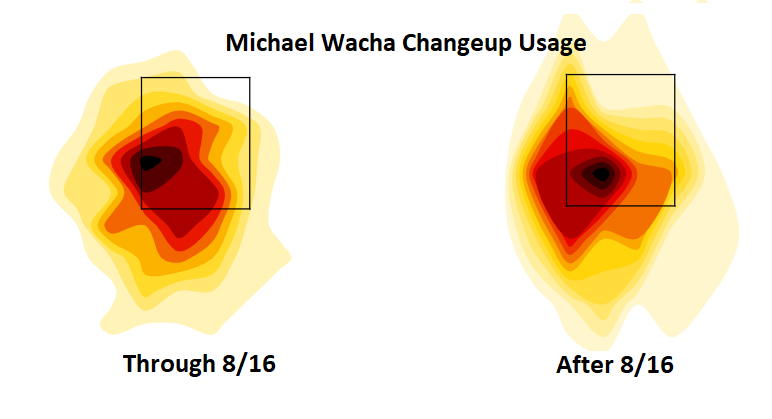The NL Central has been a wild ride this season. As we head into play on September 15, the Cardinals hold a three game lead for first place over the Cubs. St. Louis has reached this mark by quietly flipping a switch, going 20-8 over the last month. Perhaps the largest reason for that is their pitching staff. The group is ranked as the fourth-best in the league over that time span, having piled up 4.4 fWAR. Up until mid August they were definitively mediocre, though, coming in at 16th overall. They’ve made the biggest improvement in performance of any contender in either league.
The fascinating thing about this is they’re largely the same staff. They didn’t add a player at the deadline who came in, settled down right away, and boosted their overall production. They haven’t drastically changed their approach through pitch mix or anything. Rather, they’ve got two guys making incremental gains that are proving to have measurable impact: Jack Flaherty and Michael Wacha.
Shelley Verougstraete went in depth on Flaherty way back in June as the starter was working through some struggles with his breaking balls. Check it out to appreciate how he’s tightened up his slider and added depth to his curveball since then. Beyond the breakers, though, Flaherty’s tweaked his approach to add another wrinkle. He’s nearly doubled his sinker usage in the last month, taking it from 9.1% to 16.2%. This kind of move is one I’ve wrestled with all year. I blame the Rays. Knowing all we do about pitch design and what hitters have a harder time with, I can’t quite wrap my head around making the choice to throw a sinker more often. But for some guys, for some time, it just works. The easiest way to appreciate why Flaherty might have made this decision is to see it.
Here he is in July, against Kyle Seager.
https://gfycat.com/definitetastyachillestang
The pitch just seems to drift up and away. The at-bat had just started. It doesn’t give Seager any incentive to go after it. At 87 mph, it was also about four ticks slower than his average sinker.
But here he is against Adam Frazier in September.
https://gfycat.com/unacceptableadoredhornet
This time, the pitch paints the low corner for a called strike three. He ramped it up to 96 mph. Frazier hated it so much he argued the call and got tossed.
For more visual evidence, here are heat maps of Flaherty’s sinker location up through mid August, and then after.

Through mid-August, Flaherty was chucking the pitch anywhere on the third base side of the plate. Like, really… anywhere. But over the last month, he’s dropping it in the low corner of the zone with the precision of a quarterback dropping a fade into a receiver’s hands at the back of the end zone.
This is important because of the pitch’s shape. Like his slider, he’s tightened up the movement as the season has gone on. In its current state, it’s not really showing the wiggle you’d expect out of such a pitch. But it does move nearly 3.5 inches more to the glove side and has nearly four more inches of drop than his four-seamer. That combo could be creating an offering that, unlike the large majority of sinkers or two-seamers, pairs well with his other pitches while giving him a weapon he can use at hitters’ knees.
As Flaherty has represented the realization of youth and upside over the last month for the Cardinals, Michael Wacha has depicted a veteran fighting back to make a contribution. He hasn’t been another force immediately behind Flaherty in production (that would be Adam Wainwright, with .7 fWAR, but a note on him later), and he’s only been worth .2 fWAR since mid-August. But before that, he was worth -.5. But, like Flaherty did with his sinker, Wacha has seen improvements by tossing his changeup a ton more. It’s up nearly 9% over the last month, going from 21.4% to 30%.
Here’s Wacha using the changeup against JP Crawford in a 1-2 count back in July.
https://gfycat.com/freshlonelyant
This thing is flat and stays up and Crawford pounds it for a homer.
But here’s Wacha throwing a changeup to strike out Trevor Story in September.
https://gfycat.com/chubbybarecarpenterant
It looks like something Story would swing over 10 times out of 10. It has the fade that every good changeup has, burrowing toward the lower inside corner. And, like Flaherty with his sinker, the difference in effectiveness for Wacha’s changeup seems to come from being able to consistently spot it in a place that’s harder for hitters to get to.

They aren’t glamorous, but Wacha’s improvements feel like the kind that could be critical for a playoff team because now, as we race toward the stretch run and the Cardinals try to pad a divisional lead, they suddenly have one more arm to trust as the stakes reach their highest.
Even though St. Louis is enjoying a strong run from its pitching in part because of Flaherty and Wacha, other parts of the rotation may still be cause for concern. Dakota Hudson and Wainwright have combined for more than 67 innings over the last month and totaled more than a win of production. However, by K-BB%, which is one of the best indicators for in-season future success, Hudson (8.1) and Wainwright (7.4) check in about 50% worse than league average. It’s working for now, but you can only lean on unsound support for so long before it collapses.
More than not, we ask if a player’s production in the current moment can be maintained moving forward. But considering turnaround performances like Flaherty’s and Wacha’s late in the year, and even their battery mates showing warning signs, could help us stop and evaluate how well we prioritize the results they’re creating right now. After all, it’s the most important production we could have.
(Photo by Tim Spyers/Icon Sportswire)

FYI “battery mates” refers to the pitcher and catcher pair, not fellow pitchers in the rotation.